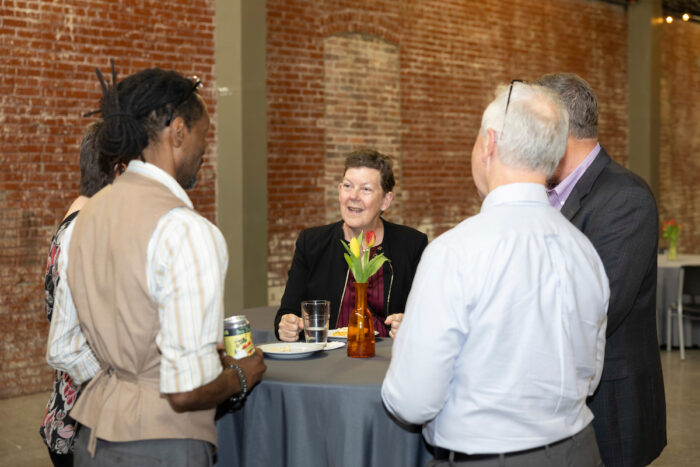Missouri State is committed to providing well-rounded educational opportunities while also maintaining good stewardship of university resources. These are big goals, and assessment and accreditation processes are key to ensuring that we consistently reach them.
The most comprehensive accreditation process that Missouri State undergoes is conducted by the Higher Learning Commission (HLC). According to HLC’s website, “Institutional accreditation validates the quality of an institution’s academic programs at all degree levels… Institutional accreditation also examines the quality of the institution beyond its academic offerings and evaluates the institution as a whole, including the soundness of its governance and administration, adherence to mission, the sustainability of its finances, and the sufficiency of its resources.” Missouri State has been continuously accredited by the HLC since 1915.
HLC Accreditation
HLC accreditation is an ongoing process. We’re currently working toward a comprehensive evaluation, which includes an on-site visit that’s scheduled for 2026. An oversight committee is directing these efforts.
Oversight Committee
Co-leads
- Mark Woolsey, Interim Director of Public Affairs and Assessment
- Mary Bohlen, Assessment and Accreditation Consultant
Members
- Dr. Algerian Hart, Assistant to the President for Inclusive Engagement
- Dr. Tamera Jahnke, Dean of the College of Natural and Applied Sciences (CNAS)
- Dr. John Jasinski, Provost
- Dr. Shawn Wahl, Dean of the Reynolds College of Arts, Social Sciences and Humanities
- Dr. Andrea Weber, Assistant Vice President for Student Affairs/Dean of Students
- Dr. Kelly Wood, Associate Vice President for Student Success
Q&A
CNAS Dean Dr. Tamera Jahnke has led Missouri State’s HLC accreditation processes in the past, and she currently serves as a peer reviewer for other institutions undergoing HLC evaluation. We chatted with her about what the process entails and what the campus community can expect as we work toward the on-site visit in 2026.
Academic Expressions: “HLC accreditation” is a term we hear so often that we may forget to stop and actually define it. From your perspective, what’s the simplest way to explain this process and why it’s so important for our university?
Tamera Jahnke: The Higher Learning Commission (HLC) is one of several regional accrediting bodies across our nation. It’s an institutional accreditor for Missouri State, meaning that — as opposed to assessing an individual program or department — it accredits our institution as a whole. The U.S. Department of Education values this type of accreditation by a regional accreditor. If you’re not accredited, you’re not eligible to receive federal funds through programs like Pell Grants. So it’s really important for the entire institution to excel in this process!
AE: How often does this happen? And where are we in the process?
TJ: An HLC team was here in 2015 for a comprehensive visit. Before these comprehensive visits, we’re required to submit a written document with evidence that shows how we meet the assessment criteria and core components for accreditation. Our last visit resulted in a successful reaffirmation of our accreditation.
Each year since 2015, we’ve submitted an annual report with enrollment and financial data to HLC. The written report and evidence are updated four years after the on-site visit; this update gets reviewed by an HLC team, but they don’t visit campus at that point. At our last four-year review, we once again received feedback that we meet all of the criteria. It’s now time to prepare for our next on-site visit in early 2026, which means we need to update our written document and the attached evidence.

AE: What framework does HLC use in its assessment?
TJ: There are set criteria. The first one is about the university’s mission. Essentially, it asks: Do you have a mission, and do you follow it? That’s good news because we have a very clear mission.
The second criterion is about integrity. It looks at our policies and procedures and assesses whether we’re following them.
The next two criteria focus on teaching and learning. They look at everything from whether we have adequate facilities and an appropriate number of faculty to how we’re articulating learning outcomes and ensuring that students are learning what we’ve said they’re going to learn.
Finally, the fifth criterion is all about planning and financial management. It asks: Do you have a strategic plan, and do you follow it? And are your finances connected to your strategic plan?
During the evaluation process, the questions arise, broadly, from these areas, so the data and examples we provide should speak to these questions. [Editor’s note: HLC regularly reviews the criteria for accreditation. Jahnke noted a current proposal to collapse the two criteria that focus on teaching and learning into one criterion called “teaching and learning for student success.” This change may be approved in June 2024. The oversight team will continue to clearly document appropriate evidence so that Missouri State can provide a complete report to reviewers for the evaluation in 2026.]
AE: What’s the best way for faculty and staff to contribute to this process?
TJ: This accreditation is for the whole university. It’s looking at everything: student affairs, academics, finances, facilities — everything. That’s why John [Jasinski] and I envisioned the oversight committee as a group with very broad perspectives. As we complete our written report and prepare for the site visit, we’ll work to ensure people know the HLC criteria, and we may ask for input. For example, faculty might get a question like, “Tell me an example of how Missouri State lives out its mission.” That’s an easy one! We should all be able to answer that.
Then, when the HLC reviewers are here for the site visit they’ll want to meet with board members, faculty, staff and students, so we’ll keep the whole campus informed. There will be open forums, where the reviewers will seek to understand whether the things we submit in our report are consistent with what people on campus tell them.
Another thing to think about is whether there’s anything you know of that we’re working to improve. If so, how did we identify the problem? And what steps are we taking to address it? That’s just part of our continuous improvement mindset — keeping our eyes open for weaknesses and addressing them to the best of our ability.
AE: I understand that you’ve served as a reviewer when other universities have gone through the HLC accreditation process. What perspective does this experience give you?
TJ: When I’m the team chairperson, I tell universities that we’re there to ensure that they are there for another 10 years. And of course, HLC wants them to be there for another 100 years! That’s why we look at the broadest range of things — finances, policies, procedures. HLC accreditation is about having someone “open up the hood” and look at it with outside eyes so that we can be around for another 100 years.

